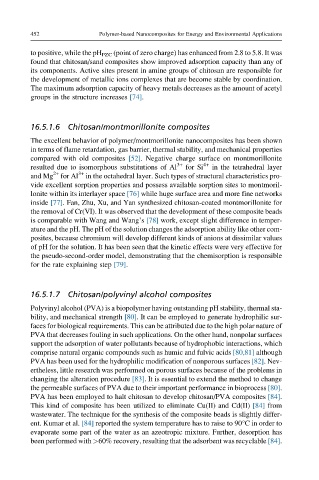Page 499 - Polymer-based Nanocomposites for Energy and Environmental Applications
P. 499
452 Polymer-based Nanocomposites for Energy and Environmental Applications
to positive, while the pH PZC (point of zero charge) has enhanced from 2.8 to 5.8. It was
found that chitosan/sand composites show improved adsorption capacity than any of
its components. Active sites present in amine groups of chitosan are responsible for
the development of metallic ions complexes that are become stable by coordination.
The maximum adsorption capacity of heavy metals decreases as the amount of acetyl
groups in the structure increases [74].
16.5.1.6 Chitosan/montmorillonite composites
The excellent behavior of polymer/montmorillonite nanocomposites has been shown
in terms of flame retardation, gas barrier, thermal stability, and mechanical properties
compared with old composites [52]. Negative charge surface on montmorillonite
resulted due to isomorphous substitutions of Al 3+ for Si 4+ in the tetrahedral layer
and Mg 2+ for Al 3+ in the octahedral layer. Such types of structural characteristics pro-
vide excellent sorption properties and possess available sorption sites to montmoril-
lonite within its interlayer space [76] while huge surface area and more fine networks
inside [77]. Fan, Zhu, Xu, and Yan synthesized chitosan-coated montmorillonite for
the removal of Cr(VI). It was observed that the development of these composite beads
is comparable with Wang and Wang’s [78] work, except slight difference in temper-
ature and the pH. The pH of the solution changes the adsorption ability like other com-
posites, because chromium will develop different kinds of anions at dissimilar values
of pH for the solution. It has been seen that the kinetic effects were very effective for
the pseudo-second-order model, demonstrating that the chemisorption is responsible
for the rate explaining step [79].
16.5.1.7 Chitosan/polyvinyl alcohol composites
Polyvinyl alcohol (PVA) is a biopolymer having outstanding pH stability, thermal sta-
bility, and mechanical strength [80]. It can be employed to generate hydrophilic sur-
faces for biological requirements. This can be attributed due to the high polar nature of
PVA that decreases fouling in such applications. On the other hand, nonpolar surfaces
support the adsorption of water pollutants because of hydrophobic interactions, which
comprise natural organic compounds such as humic and fulvic acids [80,81] although
PVA has been used for the hydrophilic modification of nonporous surfaces [82]. Nev-
ertheless, little research was performed on porous surfaces because of the problems in
changing the alteration procedure [83]. It is essential to extend the method to change
the permeable surfaces of PVA due to their important performance in bioprocess [80].
PVA has been employed to halt chitosan to develop chitosan/PVA composites [84].
This kind of composite has been utilized to eliminate Cu(II) and Cd(II) [84] from
wastewater. The technique for the synthesis of the composite beads is slightly differ-
ent. Kumar et al. [84] reported the system temperature has to raise to 90°C in order to
evaporate some part of the water as an azeotropic mixture. Further, desorption has
been performed with >60% recovery, resulting that the adsorbent was recyclable [84].

